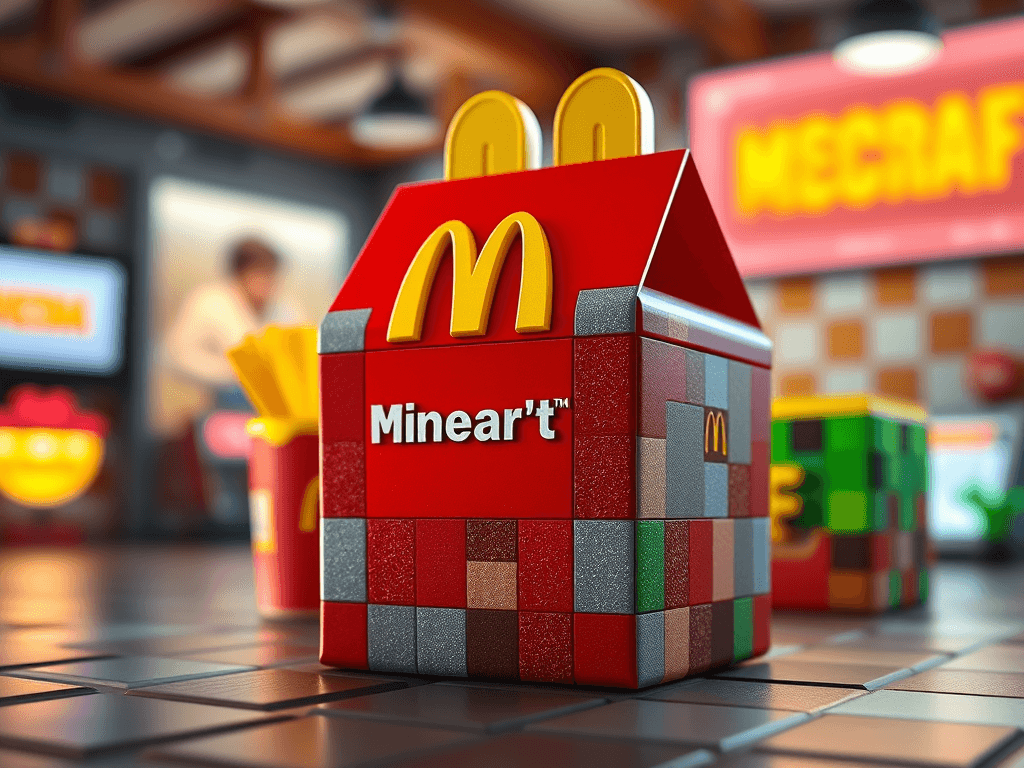The Nostalgic Return: Why McDonald’s Minecraft Meal Hits Different in 2025
The adult happy meal phenomenon emerged as a notable trend in the fast-food landscape when McDonald’s introduced its version in 2022.
This innovative offering captured the attention of millennials and adults alike, with nostalgia playing a pivotal role in its appeal.
The combination of childhood memories associated with traditional happy meals and the allure of nostalgic marketing proved to be an effective strategy.
Adults were drawn back to simpler times when fast food was a treat, and creativity stemmed from the excitement of unboxing a toy—now reimagined as collectibles.
McDonald’s utilized a strategic marketing campaign that emphasized these nostalgic connections, effectively merging elements of pop culture with their adult happy meal offerings.
By collaborating with popular brands and artists, they successfully attracted a wide demographic that extended beyond just children, resonating particularly with millennials who grew up as fans of the original happy meals.
This demographic is not only eager for a taste of nostalgia but also engages in the collector’s aspect of fast food, creating a unique intersection of food and emotional connections.
The incorporation of collectibles with meals transformed the dining experience, allowing customers to indulge in both food and the thrill of collecting.
Items in the adult happy meal ranged from various toys to limited-edition merchandise that tapped into the consumers’ desire to reminisce while enjoying a meal.
This model revolutionized the way food was consumed and perceived, positioning fast food as more than just a quick solution but as a culturally relevant experience.
The popularity of the adult happy meal may be seen as the precursor to the anticipated Minecraft meal McDonald’s has brought back in 2025, promising to rekindle that same sense of nostalgia and community among its patrons.
The Evolution of McDonald’s Collaborations
McDonald’s has a long-standing history of strategic collaborations that have shaped its menu and marketing approach.
Over the years, the fast-food giant has partnered with various franchises and pop culture phenomena, enhancing both consumer engagement and brand visibility.
These collaborations have often led to the creation of limited-time menu offerings that cater to the interests and preferences of diverse customer demographics.
One notable example was the tie-in with the movie franchise “Star Wars,” generating significant buzz and interest through themed toys and meals.
Comparatively, the upcoming 2025 Minecraft meal mcdonalds showcases a unique aspect of collaboration that integrates modern gaming culture.
Unlike previous partnerships, the Minecraft collaboration capitalizes on the dominant impact of video games in today’s entertainment landscape.
As gaming becomes a prevalent social activity among various age groups, McDonald’s demonstrates its adaptability by aligning with the Minecraft brand, which boasts an enormous, dedicated player base.
This move not only targets younger audiences but also invites parents who are familiar with the game’s legacy, creating a family-oriented experience.
Moreover, consumer engagement in these collaborations has been amplified through limited-time offers and exclusive merchandise, with the Minecraft meal mcdonalds expected to follow suit.
Gamers are often drawn to collectible items, and McDonald’s is likely to incorporate this incentive by providing exclusive in-game content or unique collectibles with the meal.
The incorporation of modern pop culture into marketing strategies illustrates McDonald’s responsiveness to shifting consumer trends and preferences.
As the gaming industry continues to thrive, partnerships like the Minecraft collaboration signify a lucrative avenue for both brand exposure and customer loyalty.
Savoring Small Pleasures: The Adult Experience

In today’s fast-paced world, adults often find themselves yearning for moments of joy that can transport them back to simpler times.
The McDonald’s Minecraft meal serves as an ideal embodiment of this phenomenon. This unique meal is not merely about food; it taps into the nostalgia that many adults feel toward their formative gaming experiences.
The inclusion of collectible toys and themed packaging transforms this meal into more than a culinary offering—it becomes a tangible connection to cherished childhood memories.
The allure of the Minecraft meal at McDonald’s has a strong psychological basis. Many adults derive happiness from engaging with items that remind them of beloved games and childhood fantasies.
In a post-pandemic context, where uncertainty has crept into daily life, the comfort of familiar brands and remnants of the past can create a sense of stability and joy.
Shows of nostalgia can stimulate dopamine release, making this meal a source of temporary reprieve from stressors that often accompany adulthood.
Moreover, the adult experience surrounding this meal is enhanced by the deep-rooted sense of community within gaming culture.
Sharing the excitement of obtaining a limited-edition Minecraft toy or discussing strategies over a meal with friends adds an element of social engagement.
This collective experience fosters connection, both with others and with one’s inner child. Consuming the McDonald’s Minecraft meal not only satiates hunger but also ignites conversations filled with enthusiasm about beloved game mechanics and cherished characters.
Altogether, the McDonald’s Minecraft meal stands as a reminder that sometimes, the smallest pleasures can evoke the greatest happiness.
The fusion of nostalgia, community, and collective joy underscores the meal’s multifaceted appeal, making it a significant experience for adults who find comfort in the playful elements of their youth.
The Future of Fast Food and Nostalgia
Nostalgia plays a pivotal role in the evolving landscape of fast food marketing, especially as brands like McDonald’s leverage emotional connections to attract a diverse range of consumers.
The nostalgic appeal of offerings such as the Minecraft meal from McDonald’s resonates particularly well with an audience that has grown up with iconic games and brands.
This collaboration has not only captured the attention of younger customers but has also drawn in adults eager to revisit their childhood memories associated with the beloved game and its merchandise.
The success of the Minecraft meal demonstrates how fast food chains may increasingly include nostalgic elements as part of their marketing strategies.
By creating products that evoke fond memories, such restaurants can differentiate themselves in a saturated market, while simultaneously appealing to the sense of sentimentality that often exists around food.
This trend could inspire other fast food outlets to develop similar retro-themed campaigns or partnerships that reflect their unique history or cultural significance, capturing consumer interest not only in the product but also in the shared experiences around it.
In terms of future direction, McDonald’s may well maintain this nostalgia-based model, particularly given the success of other nostalgic offerings, such as the adult happy meal.
As consumer preferences shift toward experiences that elicit emotional reactions, we could anticipate a broader spectrum of adult-focused fast food items that evoke nostalgia, possibly integrating various themes from popular culture.
This approach could foster a sense of community and connection among consumers, encouraging them to share their experiences and stories related to these meals.
As we look ahead, it will be intriguing to see how nostalgia continues to shape the fast food industry, encouraging conversations among consumers about their own relationships with food and memories associated with it.
Will we see more nostalgic collaborations, novel meal offerings, or items that bridge the gap between childhood and adulthood? The evolution of fast food might just open up a whole new world of tastes inspired by the past.
